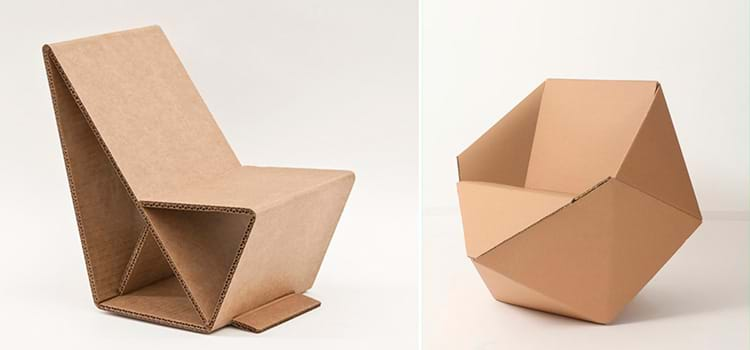With a trajectory of over 20 years, this company has distinguished itself by combining innovative design with a deep environmental awareness, offering solutions that not only meet the demand for eco-friendly alternatives but also elevate the standard of sophistication and functionality in the market.
Annunci
The history of this company is marked by a constant pursuit of innovation and sustainability. What was once considered a simple and disposable material, cardboard, gains new life in the hands of the company’s designers and craftsmen. They transform sheets and cardboard bags into pieces that challenge expectations of what is possible with this material. From elegant panels that frame corporate and cultural events to robust and functional shelves, as well as benches, tables, and chairs that blend lightness with durability, each item produced is a demonstration of the versatility and potential of cardboard as a raw material.
In addition to its aesthetic appeal, these pieces of furniture are incredibly durable and recyclable, making them an ideal option for those looking to combine style with sustainability. This innovative approach has won over various sectors, including the television industry, where cardboard furniture is frequently used as part of sets, offering a practical and eco-friendly solution without compromising visual quality.

The impact of this company on the sustainable furniture market is significant, as it not only meets the growing demand for eco-friendly products but also inspires other companies to rethink their production practices, showing that it is possible to create with environmental responsibility without sacrificing design and durability.
The practicality of these pieces is undeniable and stands out as one of the main attractions for those seeking versatile and sustainable solutions. Light and easy to handle, the pieces can be carried and assembled with extreme ease, whether by one person or with the help of another, making them ideal for events, frequent moves, or any situation that requires mobility and agility. The intuitive and uncomplicated assembly allows the furniture to be quickly put into use, without the need for special tools or advanced skills.
Even though they are made of cardboard, these pieces surprise with their strength and durability. For example, a bench can support up to 200 kilograms, demonstrating the effectiveness of the design and engineering applied in its creation. The only limitation is to avoid contact with water, which could compromise the integrity of the material. Still, under appropriate conditions, these pieces are capable of offering support and functionality comparable to traditional furniture, but with the added advantage of being lighter and easier to handle.
However, the true differentiator of this furniture lies in its sustainability, which is at the heart of the business. The company’s owner highlights that the material used—cardboard—is largely recycled. “Our material really completes the whole cycle,” she explains, emphasizing that the cardboard used comes from recycled materials, reinforcing the company’s commitment to the circular economy. At the end of the product’s life, it can be easily reintroduced into the recycling cycle, closing the loop in a responsible manner and minimizing environmental impact.
This sustainable approach not only reduces waste but also promotes environmental awareness among consumers, encouraging more eco-friendly and responsible choices. The company, therefore, not only creates innovative and practical furniture but also establishes a business model that places sustainability at the core of its operations, serving as an example for other companies seeking to integrate environmentally conscious practices into their production processes.
The demand for eco-friendly alternatives has driven the growth and diversification of the company’s product offering, which now includes around 30 different models of sustainable furniture. These pieces cater to both the domestic and business markets, focusing on providing solutions that combine lightness and low environmental impact, especially targeted at store stands, events, and television productions.
In recent years, interest in these solutions has notably increased. The company’s owner observes that the market is increasingly receptive to sustainable proposals, reflecting a significant shift in companies’ perceptions of their environmental responsibility. “Companies are very concerned about the image they project to people,” she comments, highlighting that this concern has led to a growing search for alternatives that not only fulfill their aesthetic and practical functions but also convey a genuine commitment to sustainability.
This increase in demand is particularly evident in sectors such as scenography, events, and showrooms, where visual presentation and the message conveyed are crucial. Cardboard furniture, with its unique combination of elegant design and reduced environmental impact, has proven to be a popular choice for companies that wish to align their image with more conscious and responsible practices. By adopting these solutions, companies not only contribute to reducing the use of non-recyclable materials but also reinforce their commitment to the planet’s future, which has become an increasingly valued attribute among the public and consumers.
This move towards sustainability is strongly driven by public opinion, which has become more demanding regarding responsible business practices. Consumers are increasingly aware of the environmental impact of companies and have shown a preference for those that adopt ecological and sustainable initiatives. The appreciation for practices that demonstrate environmental concern reflects a significant shift in consumption patterns, where ecological responsibility has become a decisive factor in the choice of products and services.
The São Paulo-based company, with its innovative approach to creating sustainable cardboard furniture, not only meets this new demand but also plays a crucial role in environmental awareness. By offering solutions that combine modern design, functionality, and low environmental impact, the company demonstrates that it is possible to do business responsibly and sustainably. Its practices not only contribute to environmental preservation but also serve as an example for other companies, proving that innovation and ecological responsibility can go hand in hand.
The company positions itself as an agent of change, positively influencing the market and encouraging greater awareness among consumers and entrepreneurs. By proving that it is possible to combine aesthetics, functionality, and sustainability, it contributes to building a future where responsible business practices become the norm rather than the exception.

